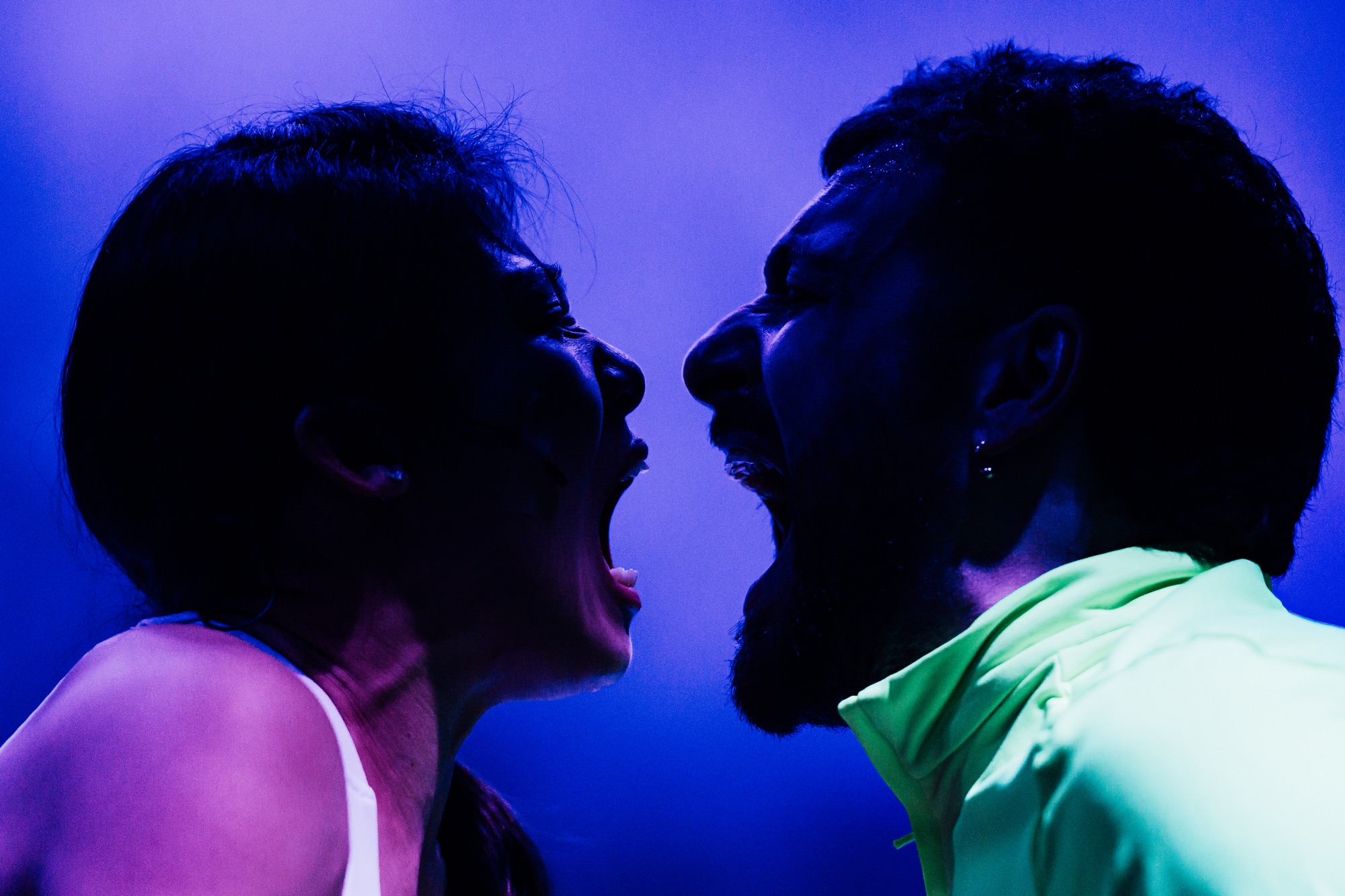Words by Josephine Leask.
Neil Yuen and Tommaso Petrolo sit in close proximity facing one another. They are quiet for a long time, eyes fixated on each other, very slowly inching their faces closer as if they are about to kiss. Then all shouting hell erupts and they fill each other’s mouths with waves of visceral noise as if trying to shout each other down. At this point the ear plugs handed out to us audience members before the show come in useful. Suddenly, their voices ragged and hoarse from the relentless shouting, they stop but keep looking in silence.
It’s a brilliant opening and stands as a metaphor for Dam Van Huynh’s new work Exquisite Noise which is about noise as a positive outlet for dissent as well as a strategy for creating assemblage, solidarity and transformation. What unfolds on stage is a high intensity, sensory experience. The company experiments with sonic noise as a disruptive force, uniting performers together in resistance, liberation and communication culminating in a collective fight for survival. Van Huynh uses the words of and refers to a wide range of inspirational artists and activists such as Robert Rauschenberg, Marina Abramovic, Jenny Holzer, Andre Lorde, bel Hooks, Trinh T. Minh-ha and Mitsuye Yamada, to create a deeply intertextual performance.
What is unique about Van Huynh’s carefully researched work is the cacophony of different layers of noise that flood the stage. This happens both visually, in the physical performance of the dancers, their shouting, speaking, rapping, beat boxing and semiotic utterings as well as in the sculptural lighting of Patricia Roldan Polo’s design and Ian Tong’s ear-splitting sound composition. While there are a few short episodes of relative peacefulness both in terms of sound and movement, such as when the dancers carefully build a safe space with a huge plastic cover, there is little let up to the overwhelming, relentless noise. The prolonged, migraine inducing strobe lighting, combined with the punishing choreography where bodies are carried, thrown about, dragged or dropped, bash the senses and overload us with questions: what can be gained by such a sensory onslaught? While it feels good to actually participate in a huge chanting protest, does it have the same effect when we watch the performance of protest in the protected space of the theatre? Could the disruptive element of noise and assemblage happen more convincingly if performed outside in a public context?
Van Huynh conceives of the dancer’s body in Exquisite Noise as the antithesis of the silent and reflective ‘neutral body’. Instead, the performers’ bodies are sites of noise, tension, friction and struggle, often appearing as one writhing pile of contorted torsos and limbs. While they form a phalanx of solidarity, looking out for each other’s backs and offering support in the form of touch or a lift, they are hyperattentive to what is happening around them. Laura Kenyon’s uneasy expression is particularly haunting as she continually glances over her shoulder at the other dancers or searchingly scans the audience. Their flight or fright mode indicates the breakdown of a peaceful protest where the will to listen dissipates and shouting and chanting soon dissolve into violence (a grim reminder of the recent anti-immigration protests seen across the UK).
The final scenes of Exquisite Sounds descend into an endurance test for the dancers amidst the state of emergency they find themselves in. Whether half- reclining or running across the stage, they shake with effort and stress, shouting in pulsing, repetitive phrases only pausing to interact with another body or the menacing objects (rubber car tyres used both as weapons to throw and objects to hide in). In what had now transformed into a riot zone, Marely Romero runs topless with outstretched arms, her face taut with terror yet determination, evoking a disturbing image of innocent victims caught in the chaos of war. In another moment, Leve Navickaite supports and drags Paul Davies’ collapsing body, barely able to walk under the strain. Strobe lighting both conceals and fragments the raw, sweating bodies and emphasises the vulnerability of humanity. Although by this point my head aches, I am captivated by the urgency of Van Huynh’s work and the staggering stamina of the dancers as they push through together.
Van Huynh’s interest in the power, freedom, strength and solidarity of protest and its ability to allow people to find their political voice, resonates with the terrifying present when democracy across the world is under threat and people’s rights and liberties are gradually being eroded. Although the transformative vision of protest is somewhat obscured by the work’s inherent violence, Van Huynh’s piece remains vital and timely.
Manhattan Photography.
